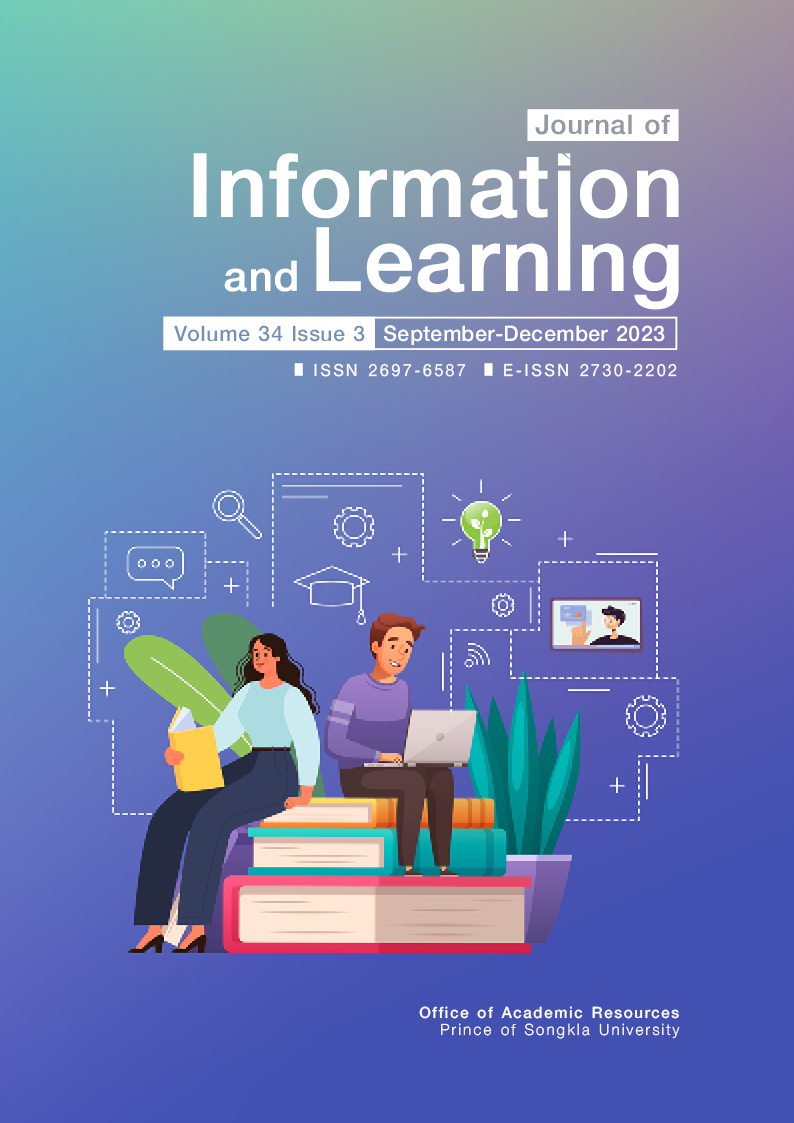Effect of Project-Based Learning Combined With Flipped Classroom on Learning Achievement, Collaboration Skills, and Student Satisfaction: A Case Study of Green Consumption at Prince of Songkla University, Pattani Campus
Main Article Content
Abstract
The objectives of this study were 1) to compare the learning achievement of students in the Green Consumption course before and after implementing of project-based learning with flipped classroom, 2) to compare the learning achievement of students against a criterion of 80%, 3) to evaluate students collaboration skills in project-based learning with flipped classroom, and 4) to assess student satisfaction with project-based learning in the flipped classroom. The participants were 509 students enrolled in the Green Consumption course in the first semester of the 2023 academic year at Prince of Songlka University, Pattani Campus. The research tools included a lesson plan, tests, and questionnaires to assess collaboration skills and satisfaction. The data were analyzed using statistics, including percentage, mean, standard deviation, one-sample t-test, and dependent t-test.
The results showed that: The learning achievement of students in the Green Consumption course higher than before implementing with statistical significance at the .01 level. The learning achievement of students in project-based learning with flipped classroom was higher than the required threshold of 80% (score of 32). Additionally, the study evaluated social skills, revealing that approximately 78.39% of the participants demonstrated good collaboration skills. The evaluation of project-based learning and the flipped classroom indicated an average satisfaction score of 4.48. This suggests that the students were highly satisfied with this teaching approach.
Article Details

This work is licensed under a Creative Commons Attribution-NonCommercial-NoDerivatives 4.0 International License.
The Journal of Information and Learning is operated by the Office of Academic Resources, Prince of Songkla University. All articles published in the journal are protected by Thailand copyright law. This copyright covers the exclusive rights to share, reproduce and distribute the article, including in electronic forms, reprints, translations, photographic reproductions, or similar. Authors own copyrights in the works they have created as well as the Office of Academic Resources. The Journal reserves the right to edit the language of papers accepted for publication for clarity and correctness, as well as to make formal changes to ensure compliance with the journal's guidelines. All authors must take public responsibility for the content of their paper.
References
Barak, M., & Dori, Y. J. (2005). Enhancing undergraduate students’ chemistry understanding through project-based learning in an IT environment. Science Education, 89(1),117-139. https://onlinelibrary.wiley.com/doi/pdf/10.1002/sce.20027
Billig, S. (2000). Research on K-12 school-based service-learning: The evidence builds. PhiDeltaKappan, 81(9), 658-664. https://digitalcommons.unomaha.edu/cgi/viewcontent.cgi?article=1003&context=slcek12
Condliffe, B., Quint, J., Visher, M. G., Bangser, M. R., Drohojowska, S., Saco, L., & Nelson, E. (2017). Project-based learning a literature review. Education Resources Information Center. https://files.eric.ed.gov/fulltext/ED578933.pdf
Duangnim, A., Napapongs, W., Kaosaiyaporn, O., Tansakul, J., & Inkaew, C. (2021). Development of massive open online learning environments to promote self-directed learning based on constructivist approach. Journal of Information and Learning, 32(3), 1-13. https://so04.tci-thaijo.org/index.php/jil/article/view/252571
Gerdtham, C. (2004). Project-based teaching techniques. Childen’ Club, Thailand.
Khattiyaman, W., (2003). Presentation of selected teaching practices according to actual conditions incurriculum subjects and general teaching [Doctoral dissertation, Chulalongkorn University]. Chulalongkorn University Intellectual Repository (CUIR). http://cuir.car.chula.ac.th/handle/123456789/65796
Marzano, R. J., Pickering, D. J., & Pollock, J. E. (2001). Classroom instruction that works: Research-based strategies for increasing student achievement. Assn for Supervision & Curriculum.
Nungchalerm, P. (2015). 21st century learning in science. Journal of Rangsit University & Learning, 9(1), 136-154. https://jrtl.rsu.ac.th/files/issues/V9N1/20150310124651.pdf
Office of the National Economic and Social Development Council. (2017). The twelfth national economic and social development plan (2017-2021). Office of the National Economic and Social Development Council. https://www.nesdc.go.th/ewt_dl_link.php?nid=9640
Panich, V. (2012). Withī sā ngō̜kān rīanrū phư̄a sit nai satawat thī 21 [Ways to create learning for students in the 21st century]. Sodsri-Saridwong Foundation.
Panich, V. (2013). Khrū phư̄a sit sāngha ʻong rīan klap thāng [Teachers for students create a flipped classroom] (2nd ed.). S.R. Printing Mass Products Company.
Pheturai, W. (2013). Achievement of flipped classroom in physical properties of rubber and polymer for undergraduate student in rubber and polymer technology program. Maejo University.
Sutthirat, C. (2016). 80 nawattakam kānčhatkān rīanrū thī nēn phū rīan pen samkhan [80 Innovations in learning management that emphasizes student focus] (7th ed.). Chulalongkorn University.
Thammaariyasakun, P., Napapongs, W., Tansakul, J., & Inkaew, C. (2023). Synthesis of a cirtual learning environment model with engineering design process to enhance students’ creative thinking skills. Journal of Information and Learning, 34(2), 1-15. https://so04.tci-thaijo.org/index.php/jil/article/view/262771
The Commission on Higher Education Standards Committee. (2022). Kēn māttrathān laksūt radap parinyā trī Phō̜.Sō̜. 2565 [Undergraduate Program Standard Criteria 2022]. https://www.ops.go.th/th/ches-downloads/edu-standard/download/1081/6942/16


